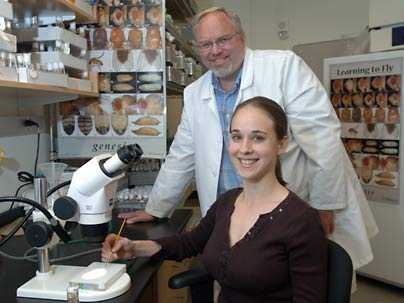Researchers at MIT's Picower Institute for Learning and Memory have found that tiny, spontaneous releases of the brain's primary chemical messengers can be regulated, potentially giving scientists unprecedented control over how the brain is wired.
The work, reported in the Sept. 16 early online edition of Nature Neuroscience, could lead to a better understanding of neurological diseases like schizophrenia.
Sputtering electrical activity--like a firecracker's leftover sparks after a big bang--was long considered inconsequential background noise compared with the main cell-to-cell interactions underlying thought and memory.
But lead author J. Troy Littleton, Fred and Carole Middleton Associate Professor of Biology at MIT, and colleagues found that the miniscule events that follow a burst of electrical and chemical activity among neurons are far more important that previously thought. A breakdown in this molecular mechanism could be the culprit in schizophrenia and other neurological diseases, the authors reported.
Neurons communicate with one another through chemical junctions called synapses. Key to the system are complexins. These small proteins play a role in the release of the brain's chemical messengers, or neurotransmitters, during synaptic cell-to-cell signaling.
To figure out exactly how complexins work, Littleton created the first genetically engineered mutant--in this case, a fruit fly--that produces no complexins at all.
There are two sides to synaptic transmission--pre-synaptic and post-synaptic. When an electrical nerve impulse zaps the pre-synaptic side, it triggers lightning-fast events that release neurotransmitters. This activates the post-synaptic cell. Mission accomplished: The foundation of a memory is formed.
The neurotransmitters are like racehorses. They champ at the bit until they get the signal to dash toward the finish line. On the pre-synaptic side, small compartments, or vesicles, containing neurotransmitters are the starting block, and complexins are the gatekeepers that prevent the neurotransmitters from releasing prematurely.
After a big burst of electrical activity sends out a flood of neurotransmitters, a few vesicles still produce some neurotransmitter. The MIT work explains the molecular machinery behind these "minis," which can occur for a few minutes after the big event. Without complexin as a gatekeeper, minis occur unchecked, leading to massive rewiring and synaptic growth.
"This spontaneous release in the brain is not only important for signaling, it can trigger synaptic growth," Littleton said. "What's really exciting is that complexin's activity may be regulated. If we can regulate this machinery, we may be able to promote synaptic growth and potentially allow targeted rewiring in areas of the brain affected in various neurological diseases."
Littleton also holds an appointment in MIT's Department of Brain and Cognitive Sciences.
Biology graduate student Sarah N. Huntwork coauthored the Nature Neuroscience paper.
This work was supported by the National Institutes of Health and the Packard Foundation for Science and Engineering.
A version of this article appeared in MIT Tech Talk on September 19, 2007 (download PDF).






